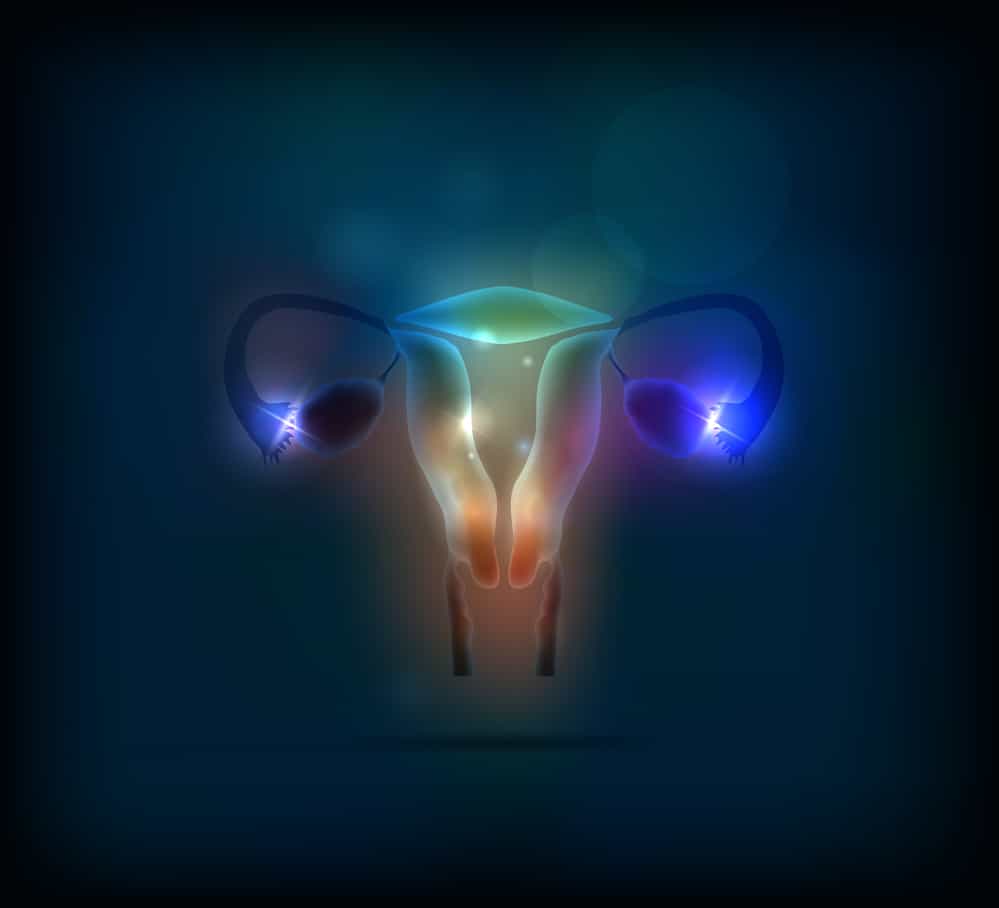
Endometriosis (sometimes referred to as “endo”) is a female-only disease and results from the lining of the uterus growing within the body outside of the uterus. This tissue acts as normal endometrial tissue, meaning it still thickens, then breaks down and bleeds during each menstrual cycle. While tissue in the uterus can exit the body during menstruation, the displaced endometrial tissue doesn’t go anywhere, and can cause irritation and swelling in surrounding tissues causing pain and potential fertility problems.
Typically, the displaced endometrial tissue can be found in the ovaries, fallopian tubes, and on the outside of the uterus. Sometimes it can be farther away from the uterus in the vagina, cervix, vulva, bowel, bladder or rectum – rarely, the tissue can appear in the lungs, brain, or skin.
It’s estimated that endo affects over 11% of reproductive-aged American women (about six million women), about 176 million women worldwide (about 10% of all women), and is more common in women who are in their 30s and 40s, often who have issues getting pregnant, and that’s when endometriosis is diagnosed.
Typically, the displaced endometrial tissue can be found in the ovaries, fallopian tubes, and on the outside of the uterus. Sometimes it can be farther away from the uterus in the vagina, cervix, vulva, bowel, bladder or rectum – rarely, the tissue can appear in the lungs, brain, or skin.
It’s estimated that endo affects over 11% of reproductive-aged American women (about six million women), about 176 million women worldwide (about 10% of all women), and is more common in women who are in their 30s and 40s, often who have issues getting pregnant, and that’s when endometriosis is diagnosed.
Causes of Endometriosis
There are several theories on what causes endometriosis; however, researchers still don’t know for sure what actually causes the disease. One suspected cause is retrograde menstruation, which means when a woman has her period, some of the uterine tissue and blood travel out through the fallopian tubes and end up in the abdominal cavity.
Researchers also suspect genetic factors since endo tends to run in families (if a sister, aunt, or other female family member has it, that increases likelihood of being diagnosed with it). Immune system problems could also be a cause, since a immune system that’s not functioning well enough could not find and destroy endometrial tissue growing outside of the uterus. Additionally, since estrogen seems to be a factor in endometriosis, there could be a hormonal cause for the disease.
There is no way to prevent endometriosis, but research suggests lowering levels of estrogen can help reduce it since estrogen is responsible for helping thicken the uterine lining during the menstrual cycle.
Researchers also suspect genetic factors since endo tends to run in families (if a sister, aunt, or other female family member has it, that increases likelihood of being diagnosed with it). Immune system problems could also be a cause, since a immune system that’s not functioning well enough could not find and destroy endometrial tissue growing outside of the uterus. Additionally, since estrogen seems to be a factor in endometriosis, there could be a hormonal cause for the disease.
There is no way to prevent endometriosis, but research suggests lowering levels of estrogen can help reduce it since estrogen is responsible for helping thicken the uterine lining during the menstrual cycle.
Signs and Symptoms
Endometriosis typically develops several years after menstruation starts, and signs and symptoms temporarily end with pregnancy, then permanently end with menopause. The main symptom of endometriosis is pain – including pelvic, lower abdominal, and pain with menstruation (dysmenorrhea). Pain can also be present during intercourse. The pain often follows a cycle, so the pain is worse right before and/or during the period, and then improves when the period is over. Some women can experience constant pelvic or lower abdominal pain.
However, while pain is the main symptom most often experienced, some women may not experience any pain, and only have particularly heavy or irregular periods. Additionally, the level of pain does not indicate the severity of the endometriosis, as a woman presenting with constant pain could have less displaced tissue than a woman with no pain.
Women with endometriosis may also experience:
However, while pain is the main symptom most often experienced, some women may not experience any pain, and only have particularly heavy or irregular periods. Additionally, the level of pain does not indicate the severity of the endometriosis, as a woman presenting with constant pain could have less displaced tissue than a woman with no pain.
Women with endometriosis may also experience:
- Problems with fertility (30-40% of women with endometriosis are subfertile)
- Bowel and bladder issues (pain with bowel movements, bloating, constipation, blood in the urine, or pain with urination)
- Abnormal vaginal bleeding (heavy or irregular)
- Fatigue
- Nausea
Diagnosis
Diagnosing endometriosis requires a doctor visit to go over symptoms and rule out other diagnoses. A doctor may perform a pelvic exam, feeling the pelvis for abnormalities, including cysts on the reproductive organs or scars behind the uterus.
If the doctor suspects endometriosis, an ultrasound can be performed (either pressed against the abdomen or inserted in the vagina). The ultrasound will give a view of the reproductive organs and while it can’t definitively identify endometriosis, it can show any cysts (endometriomas) that are associated with endometriosis.
The next step is an MRI, which shows more detailed images of internal organs and tissues. An MRI may help with giving a surgeon a better map of the locations and sizes of the displaced endometrial tissue to remove.
Finally, a laparoscopy can be performed for a definitive diagnosis. A surgeon will insert a laparoscope through a small incision in the abdomen and look for signs of displaced endometrial tissue. The surgeon can take a biopsy, or even remove the tissues during that initial surgery, depending on how things are planned and what is seen in the laparoscopy.
If the doctor suspects endometriosis, an ultrasound can be performed (either pressed against the abdomen or inserted in the vagina). The ultrasound will give a view of the reproductive organs and while it can’t definitively identify endometriosis, it can show any cysts (endometriomas) that are associated with endometriosis.
The next step is an MRI, which shows more detailed images of internal organs and tissues. An MRI may help with giving a surgeon a better map of the locations and sizes of the displaced endometrial tissue to remove.
Finally, a laparoscopy can be performed for a definitive diagnosis. A surgeon will insert a laparoscope through a small incision in the abdomen and look for signs of displaced endometrial tissue. The surgeon can take a biopsy, or even remove the tissues during that initial surgery, depending on how things are planned and what is seen in the laparoscopy.
Treatment
Treating endometriosis requires medication or surgery, and the approach will depend on how severe the symptoms are and whether or not the patient hopes to become pregnant. Typically, doctors will start with a more conservative treatment, and only opt for surgery if that fails.
Pain medication is the main treatment, usually with over-the-counter medications like NSAIDs (Aleve, Advil). When a full dose of those medications doesn’t help, other treatments are utilized. Hormonal contraceptives can help since they control estrogen (birth control pills, patches, vaginal rings) – this can also lighten and reduce periods to reduce or eliminate pain completely.
Progestin therapy is an option that comes with specific types of hormonal birth control, including the hormonal intrauterine device (IUD such as Mirena), the contraceptive shot (Depo-Provera), or progestin pills which can stop menstrual periods, thus preventing the growth of displaced endometrial tissue and reducing signs and symptoms.
Medications used to lower estrogen and prevent menstruation (that aren’t specific birth control medications) can also be used. These drugs create artificial menopause, but can be accompanied with side effects such as hot flashes, vaginal dryness, and bone loss.
If a woman has endometriosis and is trying to become pregnant, surgery to remove the displaced endometrial tissue is used to protect the uterus and ovaries. The surgery can be done laparoscopically or (less traditionally) using abdominal surgery. Even after surgery, endometriosis signs and symptoms can return when the tissue becomes displaced again.
A final endometriosis treatment option that used to be the most effective treatment but is now used much less frequently is removing the uterus and ovaries completely. However, this means that any displaced endometrial tissue left in the body could continue to cause pain, but there would be no new tissue added.
Pain medication is the main treatment, usually with over-the-counter medications like NSAIDs (Aleve, Advil). When a full dose of those medications doesn’t help, other treatments are utilized. Hormonal contraceptives can help since they control estrogen (birth control pills, patches, vaginal rings) – this can also lighten and reduce periods to reduce or eliminate pain completely.
Progestin therapy is an option that comes with specific types of hormonal birth control, including the hormonal intrauterine device (IUD such as Mirena), the contraceptive shot (Depo-Provera), or progestin pills which can stop menstrual periods, thus preventing the growth of displaced endometrial tissue and reducing signs and symptoms.
Medications used to lower estrogen and prevent menstruation (that aren’t specific birth control medications) can also be used. These drugs create artificial menopause, but can be accompanied with side effects such as hot flashes, vaginal dryness, and bone loss.
If a woman has endometriosis and is trying to become pregnant, surgery to remove the displaced endometrial tissue is used to protect the uterus and ovaries. The surgery can be done laparoscopically or (less traditionally) using abdominal surgery. Even after surgery, endometriosis signs and symptoms can return when the tissue becomes displaced again.
A final endometriosis treatment option that used to be the most effective treatment but is now used much less frequently is removing the uterus and ovaries completely. However, this means that any displaced endometrial tissue left in the body could continue to cause pain, but there would be no new tissue added.
EMS and Endo
The main reason EMS could be called to a patient with endometriosis would be severe pain. Endometriosis can mimic the pain pattern in appendicitis, since the pain can be concentrated on just one side of the lower abdomen and present with nausea/vomiting/diarrhea.
Since EMTs don’t dispense pain medication, this patient should go to the hospital for more definitive treatment with a doctor. However, an EMT can help assess the history of the symptoms of endometriosis (whether or not it has been diagnosed) through the patient history.
Since EMTs don’t dispense pain medication, this patient should go to the hospital for more definitive treatment with a doctor. However, an EMT can help assess the history of the symptoms of endometriosis (whether or not it has been diagnosed) through the patient history.
Sources and More Information
Endometriosis.org, “FAQs” https://endometriosis.org/frequently-asked-questions-faq/
Mayo Clinic, “Endometriosis” https://www.mayoclinic.org/diseases-conditions/endometriosis/symptoms-causes/syc-20354656
Office on Women’s Health, “Endometriosis” https://www.womenshealth.gov/a-z-topics/endometriosis
UCLA Obstetrics and Gynecology, “Endometriosis” https://obgyn.ucla.edu/endometriosis
Mayo Clinic, “Endometriosis” https://www.mayoclinic.org/diseases-conditions/endometriosis/symptoms-causes/syc-20354656
Office on Women’s Health, “Endometriosis” https://www.womenshealth.gov/a-z-topics/endometriosis
UCLA Obstetrics and Gynecology, “Endometriosis” https://obgyn.ucla.edu/endometriosis


